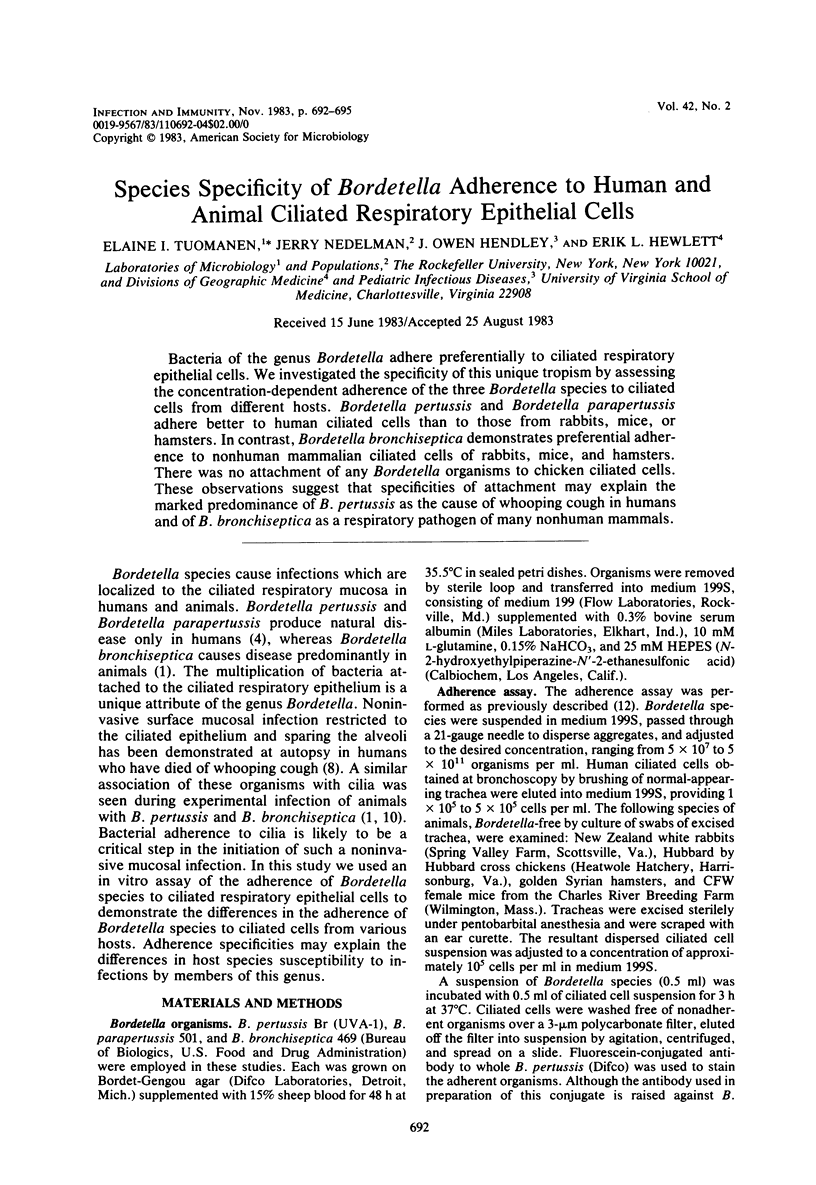Species specificity of Bordetella adherence to human and animal ciliated respiratory epithelial cells (original) (raw)
Abstract
Bacteria of the genus Bordetella adhere preferentially to ciliated respiratory epithelial cells. We investigated the specificity of this unique tropism by assessing the concentration-dependent adherence of the three Bordetella species to ciliated cells from different hosts. Bordetella pertussis and Bordetella parapertussis adhere better to human ciliated cells than to those from rabbits, mice, or hamsters. In contrast, Bordetella bronchiseptica demonstrates preferential adherence to nonhuman mammalian ciliated cells of rabbits, mice, and hamsters. There was no attachment of any Bordetella organisms to chicken ciliated cells. These observations suggest that specificities of attachment may explain the marked predominance of B. pertussis as the cause of whooping cough in humans and of B. bronchiseptica as a respiratory pathogen of many nonhuman mammals.

Selected References
These references are in PubMed. This may not be the complete list of references from this article.
- Bemis D. A., Greisen H. A., Appel M. J. Pathogenesis of canine bordetellosis. J Infect Dis. 1977 May;135(5):753–762. doi: 10.1093/infdis/135.5.753. [DOI] [PubMed] [Google Scholar]
- Cheney C. P., Schad P. A., Formal S. B., Boedeker E. C. Species specificity of in vitro Escherichia coli adherence to host intestinal cell membranes and its correlation with in vivo colonization and infectivity. Infect Immun. 1980 Jun;28(3):1019–1027. doi: 10.1128/iai.28.3.1019-1027.1980. [DOI] [PMC free article] [PubMed] [Google Scholar]
- Ellen R. P., Gibbons R. J. M protein-associated adherence of Streptococcus pyogenes to epithelial surfaces: prerequisite for virulence. Infect Immun. 1972 May;5(5):826–830. doi: 10.1128/iai.5.5.826-830.1972. [DOI] [PMC free article] [PubMed] [Google Scholar]
- GORDON J. E., HOOD R. I. Whooping cough and its epidemiological anomalies. Am J Med Sci. 1951 Sep;222(3):333–361. doi: 10.1097/00000441-195109000-00011. [DOI] [PubMed] [Google Scholar]
- Isaacson R. E., Fusco P. C., Brinton C. C., Moon H. W. In vitro adhesion of Escherichia coli to porcine small intestinal epithelial cells: pili as adhesive factors. Infect Immun. 1978 Aug;21(2):392–397. doi: 10.1128/iai.21.2.392-397.1978. [DOI] [PMC free article] [PubMed] [Google Scholar]
- Jones G. W., Freter R. Adhesive properties of Vibrio cholerae: nature of the interaction with isolated rabbit brush border membranes and human erythrocytes. Infect Immun. 1976 Jul;14(1):240–245. doi: 10.1128/iai.14.1.240-245.1976. [DOI] [PMC free article] [PubMed] [Google Scholar]
- Marks M. I., Stacy T., Krous H. F. Progressive cough associated with lymphocytic leukemoid reaction in an infant. J Pediatr. 1980 Jul;97(1):156–160. [PubMed] [Google Scholar]
- Ofek I., Beachey E. H. Mannose binding and epithelial cell adherence of Escherichia coli. Infect Immun. 1978 Oct;22(1):247–254. doi: 10.1128/iai.22.1.247-254.1978. [DOI] [PMC free article] [PubMed] [Google Scholar]
- Tuomanen E. I., Hendley J. O. Adherence of Bordetella pertussis to human respiratory epithelial cells. J Infect Dis. 1983 Jul;148(1):125–130. doi: 10.1093/infdis/148.1.125. [DOI] [PubMed] [Google Scholar]